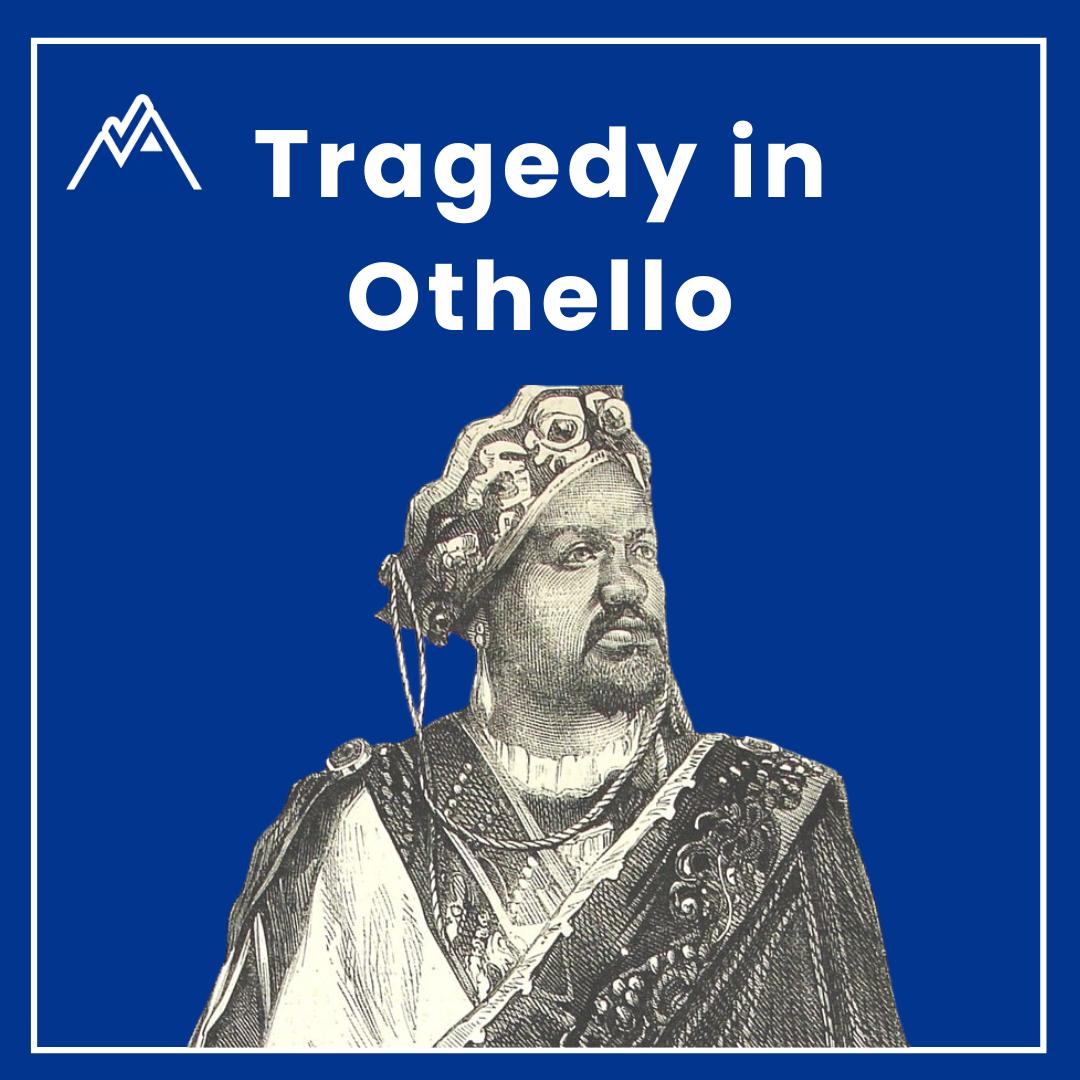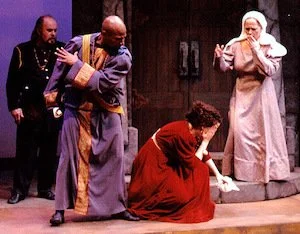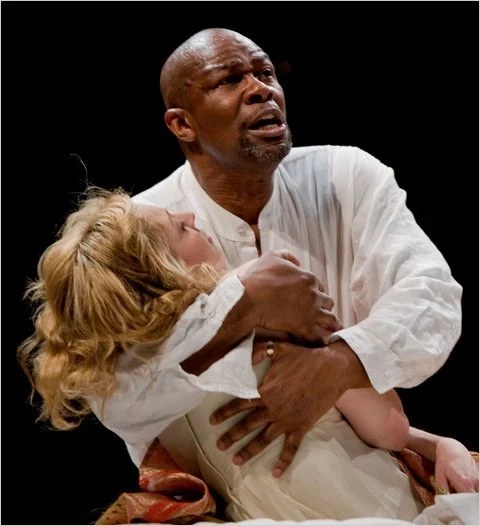Tragedy in Othello - How to Use Form in Your Essays
Shakespeare’s Othello is often described as one of the purest examples of tragedy in the Western canon. But why? The answer lies in Aristotle’s Poetics (4th century BCE), which defined tragedy as the downfall of a noble hero through a fatal flaw (hamartia), often accompanied by excessive pride (hubris), leading to a reversal of fortune (peripeteia) and a moment of recognition (anagnorisis).
The purpose of tragedy, according to Aristotle, is to provoke pity and fear in the audience, which are then released through an emotional purging (catharsis).
Othello fits this tragic model almost perfectly. Below, we’ll explore each Aristotelian element in detail, showing how Shakespeare dramatizes them, and how you can use this framework in your essays.
1. The Tragic Hero
What it is: A hero that had the potential to be great, to go on a hero’s journey and be successful and obtain a happy ending, however due to manipulation or one’s hamartia, fails and generally dies in regret
In Othello:
Othello begins as the “valiant Moor,” admired for his military service and eloquence before the Venetian Senate.
His storytelling wins Desdemona’s love, and his authority makes him central to the Venetian state.
Yet he is also an outsider: a black man in a predominantly white, Christian society. His nobility is therefore fragile, resting on reputation and trust.
Why it matters: Othello’s initial status heightens the tragedy of his downfall. He had the potential for greatness (both as general and as husband) but is undone by his flaws
2. Hamartia
What it is: Also known as the ‘fatal flaw,’ the hamartia is the flaw or error that sets the hero’s downfall in motion.
In Othello:
His credulity: Othello’s readiness to believe Iago.
His insecurity: He fears Desdemona’s love cannot be stable because of his race, age, and status, and is quick to believe she could be cheating on him.
His demand for certainty: His soldier’s mindset makes him crave “ocular proof.” When Iago supplies false evidence (Cassio’s laughter, the handkerchief), Othello mistakes it for absolute truth and trusts him completely
Why it matters: This shows how an admirable quality (trust, decisiveness) can become destructive in the wrong circumstances.
3. Hubris (Excessive Pride)
What it is: An important component of a tragic hero's demise and a defining feature of a hero's personality is their hubris. It characterises a hero's fatal weakness, which eventually causes them to overlook a divine warning or break morality in order to get closer to their objective. The remainder of the characters experience catharsis and the tragic hero ultimately dies as a result of this.
In Othello:
Othello decides he has the authority to kill Desdemona: “Yet she must die, else she’ll betray more men.”
His pride blinds him to justice, turning him from general to executioner.
Hubris is also visible in his conviction that his judgment cannot be wrong - even when based on weak evidence like the handkerchief
Othello’s hubris combines with his hamartia. His trust in Iago feeds his pride in judgment, creating a closed loop where doubt and arrogance reinforce each other.
4. Peripeteia (Reversal of Fortune)
Peripeteia is the hero’s turning point — when rising fortunes collapse into inevitable doom. In Shakespeare, this often unfolds through multiple stages, not one moment.
In Othello
Physical collapse: Once a commanding general, Othello convulses in jealous fits. This starkly contrasts with his earlier composure when he calmly resisted Brabantio’s accusations. His body reflects his psychological disintegration.
Spying on Cassio: Othello stoops to eavesdropping on Iago’s staged conversation. This furtive act diminishes his dignity. From central general, he becomes a marginal figure — literally hiding at the edges of the stage.
Breakdown of language: In the Senate, Othello’s speech flows in persuasive, elevated blank verse. By Act 4, his exchanges with Iago fracture into short, chaotic lines, echoing Iago’s words instead of thinking independently. This collapse of eloquence mirrors the collapse of self.
Blasphemy: Othello curses Desdemona’s supposed betrayal with “Zounds!” (“God’s wounds”), a profanity that violates the third commandment. This signals he has passed beyond moral and spiritual redemption — his fall is no longer only social but cosmic.
Animalistic imagery: Othello exits one scene crying “Goats and monkeys!” This outburst reduces him from noble general to beast-like figure, aligning him with Iago’s earlier crude animal imagery.
Violence against Desdemona: His slap of Desdemona before others is perhaps the most shocking reversal. Public violence replaces private tenderness, marking the point of no return.
Reducing Desdemona to a prostitute: When he gives Emilia money for her “pains,” Othello symbolically treats Desdemona as a whore. His moral collapse is complete: he no longer distinguishes devotion from degradation.
Peripeteia in Othello is not one sudden fall but a sequence of degradations - physical, linguistic, moral, spiritual. Each stage strips Othello further of dignity until only ruin remains.
5. Anagnorisis
What it is: Anagnorisis is the moment of recognition, when the tragic hero finally realises the truth — though usually too late to act upon it.
In Othello:
After murdering Desdemona, Othello discovers she was innocent and that Iago was guilty all along.
His self-description - “one that loved not wisely but too well” - reflects both his devotion and his blindness.
His anagnorisis deepens the tragedy: we pity him precisely because he sees clearly only once it is irreversible.
6. Catharsis
What it is: Catharsis is the emotional release produced in the audience by witnessing tragedy. Aristotle argued that tragedy should stir pity and fear, which are then purged through the hero’s downfall.
In Othello:
We pity Desdemona’s innocence and fear Othello’s destructive jealousy.
Othello’s suicide is both punishment and release: he takes responsibility for his crime, but too late to save Desdemona.
For the audience, the play provokes a powerful catharsis: sorrow, horror, and finally recognition of the dangers of pride, jealousy, and misplaced trust
Conclusion
By Aristotle’s standards, Othello is a near-perfect tragedy. Shakespeare presents Othello as a noble hero whose hamartia and hubris set off a harrowing peripeteia, culminating in an anagnorisis that comes too late and leaving the audience in catharsis. These Aristotelian elements aren’t just literary theory — they’re a roadmap for your essays. If you can show how Othello fits this tragic pattern, using terms like hamartia, hubris, peripeteia, anagnorisis, and catharsis alongside key quotes, you immediately lift your analysis to a more sophisticated level.
At Pinnacle Learners, we teach students how to use frameworks like Aristotle’s tragedy to structure stronger essays, connect ideas to the text, and impress exam markers. If you want personalised help mastering Shakespeare and turning theory into Band 6 analysis, get in touch - we’d love to support you on your journey.






